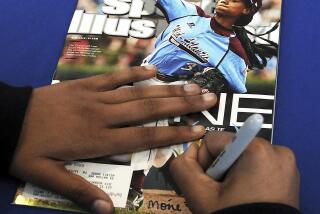The Sporting News Is Now 100 Years Old and Planning to Reach New Readers
ST. LOUIS — The Sporting News has survived five wars, the Great Depression and the onslaught of television and it celebrated its 100th birthday on March 17.
But the Bible of Baseball, as it is known, doesn’t plan to stand pat over the next century, and is instituting changes aimed at making it the Bible of Sports.
“It is unique,” said Tom Barnidge, news editor of the sports weekly. “We give reports on all the sports from correspondents across the country and deliver it each week to your mailbox and we do it 52 weeks a year.
“It’s almost a miracle.”
The miracle began when Alfred and Charles Spink began the publication in 1886 as a combination baseball and theatrical magazine. A year later, Charles Spink took over and dropped theatrics to concentrate on baseball.
Upon his death in 1914, his son, J.G. Taylor Spink succeeded him.
Taylor Spink ran the publication for 48 years until his death in 1962. His son, C.C. Johnson Spink, was in charge until he sold it to the Times-Mirror Co. in 1977.
With Times-Mirror, changes began to upgrade the venerable publication.
The Sporting News since has doubled its circulation to 711,000 and now has a goal of a million readers. To reach that milestone, the nation’s oldest sports publication is making revisions--some distressful to its loyal subscribers.
Barnidge, who took over as editor last July, views the changes as a series of steps that will pull the magazine into the modern age of publishing.
Barnidge has joined forces with Richard Waters, the publication’s president who formerly was an associate dean of the Harvard Business School and an editor at Reader’s Digest for 25 years. Together, the two are revamping the magazine into its present livelier style.
“We hired Robert Lockwood, a graphics consultant, and he had some recommendations,” Barnidge said. “We wanted to modernize. We took his suggestions and made some compromises.”
The most noticeable change is the cover. Once dominated by a single photograph of a sports personality, the cover now has three or four color shots plus teasers to inside stories.
The inside format went to five columns instead of three to allow for better layout and use of photographs. In fact, the magazine finally hired a photo editor.
Three longtime columnists--Joe Falls, Furman Bisher and Larry King--were replaced with younger writers. Veteran writer Dick Young quit over the handling of his column. Two national correspondents were added to emphasize investigative topics such as drugs in sports.
“We’re trying to broaden our audience,” Barnidge said. “It’s like the packaging of soap or a box of cereal.”
Waters notes that the changes have not come easy for readers. He said negative letters outnumber positive by a 5-1 margin.
“But I’m talking only about 125 negative letters,” Waters said. “We think the new graphics is a big improvement. I had one fellow who wrote and said he had been a subscriber for 50 years and said he was disappointed.
“I personally wrote back to him to explain our decisions. We have hardcore readers but we want to get the ones on the fringe. That’s why I want us to develop a more quick-read type of section like USA Today.”
In an effort to make the company stronger and more profitable, Waters has entered other ventures such as book publishing. Besides the annual sports guides, the company has had success with sports trivia books as well as tomes on Pete Rose and Heisman Trophy winners.
In addition, The Sporting News has a daily radio sports program on 400 stations and has two television programs in the works.
This summer, the magazine will offer a 900 telephone number for fans to call for the latest in sports news. Waters said the information will be updated every half hour.
Down the road, Waters said he wants to abandon newsprint and use a better quality of paper. Also, he would like to have the magazine bound and stitched.
“There will be those who will not like us changing that, but it will be better for our advertisers,” Waters said. “A better quality of paper will enable us to use more color.”
While the magazine plans for its next 100 years, it also is celebrating its first century in business. Already on the newsstands is an anniversary issue and a hardcover book about its history written by former managing editor Lowell Reidenbaugh, who has been with the magazine since 1947.
“We’ve gone from the shoestring operation of the Spink era to a sophisticated one now,” Reidenbaugh said. “All in all, it’s been very rewarding.”
More to Read
Go beyond the scoreboard
Get the latest on L.A.'s teams in the daily Sports Report newsletter.
You may occasionally receive promotional content from the Los Angeles Times.










